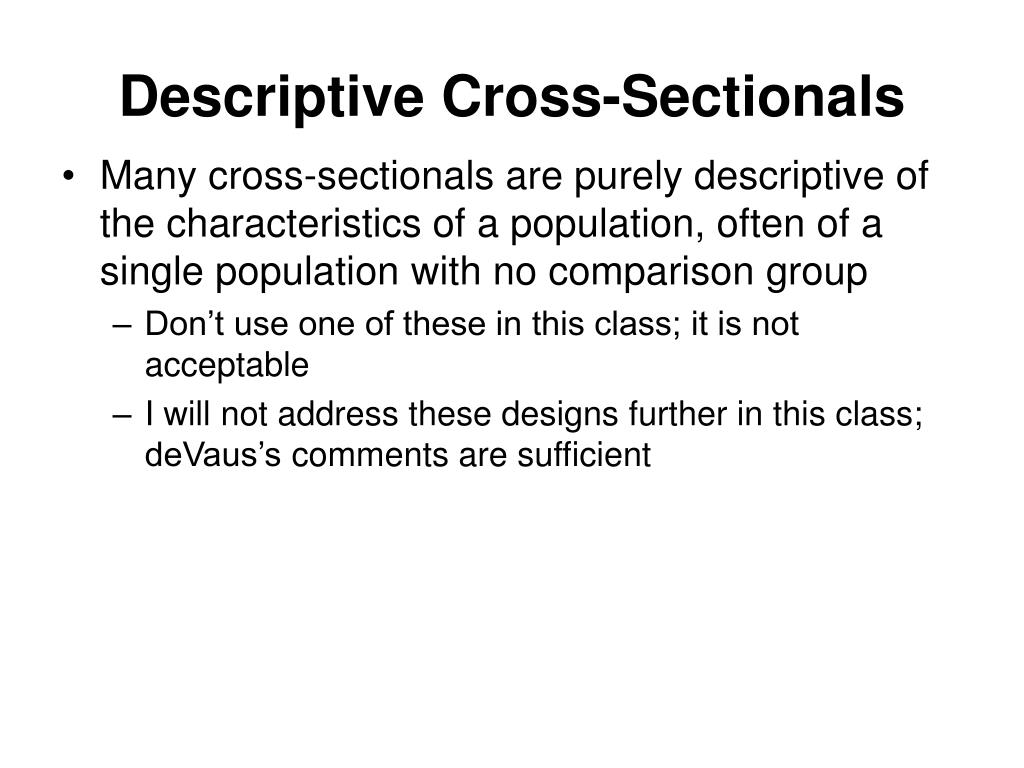Table Of Content

One of the advantages of cross-sectional studies is that data is collected all at once, so participants are less likely to quit the study before data is fully collected. Researchers can't always be sure that the conditions a cross-sectional study measures are the result of a particular factor's influence. In many cases, the differences among individuals could be attributed to variation among the study subjects. In this way, cause-and-effect relationships are more difficult to determine in a cross-sectional study than they are in a longitudinal study. For example, a university might post a short online survey about library usage habits among biology majors, and the responses would be recorded in a database automatically for later analysis. This is a simple, inexpensive way to encourage participation and gather data across a wide swath of individuals who fit certain criteria.
Correlation among simulation educational satisfaction, simulation design, and flow
By understanding the different types of cross-sectional studies, researchers can select the most appropriate design to obtain reliable and relevant data. Below are four common types of cross-sectional studies, each with its unique focus and application. Cross-sectional studies can be categorized into different types based on their objectives and methodologies. These variations allow researchers to adapt the cross-sectional approach to suit specific research questions and contexts.
MIT engineers design a robotic replica of the heart's right chamber - MIT News
MIT engineers design a robotic replica of the heart's right chamber.
Posted: Fri, 08 Dec 2023 08:00:00 GMT [source]
Methodology Series Module 3: Cross-sectional Studies
Prevalence is the proportion of people in a population (sample) who have an attribute or condition at a specific time point (Mann, 2012) regardless of when the attribute or condition first developed (Wang & Cheng, 2020). Additionally, each study participant’s evaluation is completed at one time-point with no follow-ups (Cummings, 2013), providing a ‘snapshot’ of the sample. Cross-sectional designs can be implemented as an interview or survey and may also collect physiological data and biological samples.
How to perform a cross-sectional study
The cross-sectional design is an appropriate method to determine the prevalence of a disease, attribute, or phenomena in a study sample. The design provides a ‘snapshot” of the sample, and investigators can describe their study sample and review associations between the collected variables (independent and dependent). The observational nature makes it relatively quick to complete a study and provides data to support future studies that might lead to methods to treat or prevent diseases or conditions. The design’s inherent nature makes it inexpensive to conduct and can yield multiple independent (predictor) and dependent (outcome) variables (Cummings, 2013). The data collected can lead to additional studies to build upon the knowledge obtained.
Other students also liked
Unlike longitudinal studies that observe the same subjects over a period of time to detect changes, cross-sectional studies focus on finding relationships and prevalences within a predefined snapshot. This method is particularly useful for understanding the current status of a phenomenon or to identify associations between variables without inferring causal relationships. This study used a cross-sectional design, which can only capture the associations between variables at one point in time. Therefore, understanding the causality of the relationships between variables requires further studies. The survey was carried out at three Korean universities using a non-probability convenience sampling design, which calls into question the generalizability of the findings.

The next step was adjusting for nonresponse for households without a completed screener interview to create a final household weight. This adjustment allocated the weights of nonrespondents (category 2) to those of respondents (category 1) within classes defined by the cross-classification of sampling strata, census region, and sample type (e.g., ABS and list supplemental samples). Those classes with fewer than 50 sampled addresses or large adjustment factors were collapsed with nearby cells within the sample type. Given the large variance in the household weights among the medium density ABS stratum, final household weights for addresses within this stratum were capped at 300.
Contents
Forest Futures examines intersection of nature and design - The Architect's Newspaper
Forest Futures examines intersection of nature and design.
Posted: Fri, 16 Feb 2024 08:00:00 GMT [source]
Tigecycline emerged the most effective antibiotic with 100% sensitivity while ampicillin registered 100% resistance. Six out of 19 (32%) antibiotics had greater than 50% sensitivity (ciprofloxacin 55%, ceftriaxone 54%, piperacilin/tazobactam 53%, ertapenem 65%, chloramphenicol 61% and Tigecycline 100%). Chloramphenicol, ertapenem and Tigecycline had the highest sensitivity in the ascending order. Performance of common antibiotics for treating STIs was quite poor with gentamycin and doxycycline registering sensitivity of 39% and 12% respectively (Fig. 1). Rumphi district hospital laboratory is accredited by Southern Africa Development Community Accreditation Service (SADCAS). The laboratory has been implementing quality management systems (QMS) for the past twelve years.
Cross-sectional study
You could also use them in medical research or when building a marketing strategy, for instance. Cross-sectional studies are usually cheaper to conduct than longitudinal studies, so they are ideal if you have a limited budget. A descriptive cross-sectional survey or study assesses how commonly or frequently the primary variable occurs within a select demographic. This study type is commonly used in clinical research, business-related studies, and population studies. Groups can be affected by cohort differences that arise from the particular experiences of a group of people. For example, individuals born during the same period might witness the same important historical events, but their geographic regions, religious affiliations, political beliefs, and other factors might affect how they perceive such events.
Is a cross-sectional study prospective or retrospective?
It can be used to assess the prevalence of outcomes and exposures, determine relationships among variables, and generate hypotheses about causal connections between factors to be explored in experimental designs. A cross-sectional study design is a type of observational study, or descriptive research, that involves analyzing information about a population at a specific point in time. In the first stage, a short screening survey was administered to a national sample of U.S. adults to collect basic demographics and determine a respondent’s eligibility for the extended survey of Asian Americans. Screener respondents were considered eligible for the extended survey if they self-identified as Asian (alone or in combination with any other race or ethnicity).
This is a set back as clinicians will continue to prescribe less effective antibiotics based on availability or affordability. Regarding PPS, our interest was to determine frequency of antibiotics use as well as compliance with standard guidelines. The findings revealed that ceftriaxone (54.3%) and metronidazole (23.3%) were the most commonly used antibiotics in the wardsFootnote 1. Other antibiotics were gentamycin (5.3%), flucloxacillin (4.3%) and penicillin G (4.2%) (Fig. 2). Stockouts of essential antibiotics such as ceftriaxone and penicillin G were reported during PPS data collection.
Cross-sectional studies capture data at a one-time point, while longitudinal studies track the same individuals over an extended period to observe changes. If a significant number of men from a particular age group are more prone to have the disease, the researcher can conduct further studies to understand the reasons. A longitudinal study is best used, in this case, to study the same participants over time. For example, suppose you’re interested in how respondent age or gender affects their opinions about vaping and health. In that case, you might gather both demographic and opinion-related data, allowing you to conduct correlational analysis across these variables. Generally aim to provide estimates of the characteristics of a sample, their attitudes, behaviors, or traits.
These studies focus on 'what exists' or 'what is prevalent' without delving into relationships between variables or concepts. A reporting guideline for cross-sectional studies is available for investigators and consumers of research to use. A reporting guideline’s primary goal is to ensure that published clinical research studies provide transparency in reporting a study’s conduct (what was done) and results.
On the other hand, longitudinal studies excel in observing how variables evolve, providing insights into dynamics and causal pathways. However, longitudinal data collection requires more resources, time, and a rigorous design to manage participant attrition and ensure consistent data collection over the study period. Cross-sectional designs help determine the prevalence of a disease, phenomena, or opinion in a population, as represented by a study sample.
A cross-sectional study will include several variables and sample groups, meaning it will collect data for all the different sample groups at once. However, in longitudinal studies, the same groups with similar variables can be observed repeatedly. The key difference is that a cross-sectional study is designed to look at a variable at a particular point in time. A longitudinal study evaluates multiple measures over an extended period to detect trends and changes.
The similarity in the ranking of simulation design sub-factor scores in this study and previous studies suggests that efforts are needed to strengthen the simulation design capabilities of Korean nurse educators. To increase fidelity, simulation technology support should be provided at the school level. In addition, since simulation is a recently utilized teaching method in Korean nursing education, most nurse educators lack experience in simulation education.
Data was de-identified during extraction and uploaded in specific portal for analysis at Antwerp University (AU) in Belgium. The hospital antimicrobial stewardship team received analyzed results from AU after two months through email. Secondary AST data records for both in-patients and out-patients whose majority are cases that never responded to first line antibiotic treatment during the period of 2019 to 2023, were analyzed in this study. Determination of treatment failure was based on the clinician’s judgment and was recorded in the patient case notes as persistence or worsening of signs and symptoms during the course of antibiotic treatment.

No comments:
Post a Comment